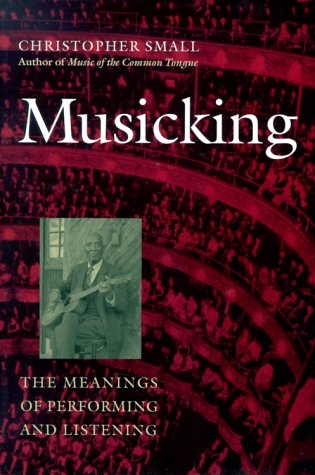Christopher Small: Musicking: The Means of Performing and Listening (1998)
Filed under book | Tags: · aesthetics, culture, ethnomusicology, music, philosophy

Extending the inquiry of his early groundbreaking books, Christopher Small strikes at the heart of traditional studies of Western music by asserting that music is not a thing, but rather an activity. In this new book, Small outlines a theory of what he terms “musicking,” a verb that encompasses all musical activity from composing to performing to listening to a Walkman to singing in the shower.
Using Gregory Bateson’s philosophy of mind and a Geertzian thick description of a typical concert in a typical symphony hall, Small demonstrates how musicking forms a ritual through which all the participants explore and celebrate the relationships that constitute their social identity. This engaging and deftly written trip through the concert hall will have readers rethinking every aspect of their musical worlds.
Publisher Wesleyan University Press, 1998
ISBN 0819522570, 9780819522573
Length 230 pages
Michel Chion: Audio-Vision: Sound on Screen (1990–) [FR, ES, EN]
Filed under book | Tags: · aesthetics, cinema, film, film history, music, music history, music video, sound recording, television, video art

“In Audio-Vision: Sound on Screen, French critic and composer Michel Chion reassesses audiovisual media since the revolutionary 1927 debut of recorded sound in cinema, shedding crucial light on the mutual relationship between sound and image in audiovisual perception.
Chion argues that sound film qualitatively produces a new form of perception: we don’t see images and hear sounds as separate channels, we audio-view a trans-sensory whole. Expanding on arguments made in his influential books The Voice in Cinema and Sound in Cinema, Chion provides lapidary insight into the functions and aesthetics of sound in film and television. He considers the effects of such evolving technologies as widescreen, multitrack, and Dolby; the influences of sound on the perception of space and time; and the impact of such contemporary forms of audio-vision as music videos, video art, and commercial television. Chion concludes with an original and useful model for the audiovisual analysis of film.”
First published as L’audio-vision: son et image au cinéma, Nathan, Paris, 1990.
English edition
Edited and translated by Claudia Gorbman
Foreword by Walter Murch
Publisher Columbia University Press, 1994
ISBN 0231078986, 9780231078986
239 pages
Publisher (EN)
L’audio-vision: son et image au cinéma (French, 3rd ed., 1990/2017, added on 2020-9-19)
La audiovisión: Introducción a un análisis conjunto de la imagen y el sonido (Spanish, trans. Antonio Lopez Ruiz, 1993, unpaginated, added on 2014-3-8)
Audio-Vision: Sound on Screen (English, trans. Claudia Gorbman, 1994, updated on 2012-7-17)
George Stiny, James Gips: Algorithmic Aesthetics: Computer Models for Criticism and Design in the Arts (1978)
Filed under book | Tags: · aesthetics, computer art, design, graphics, music, software

“Can a computer appreciate a work of art? Can a computer create a new work of art? What does it mean for an object to be a work of art? How are objects understood as works of art? Dozens of ways of understanding art have been proposed. Is there one true way to understand works of art? If not, what do the different ways of understanding art have in common? How might they be implemented in a computer? Does this “computer” or “algorithmic” approach have any contributions to make to the field of art and aesthetics?
The book was written between 1974 and 1976 in Los Angeles. We had no access to a computer so we employed a typist to translate our hand written pages into typed manuscript.”
Publisher University of California Press, 1978
ISBN 0520034678
220 pages

